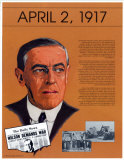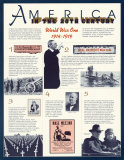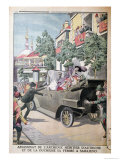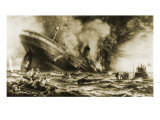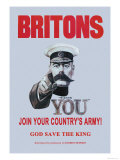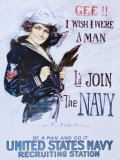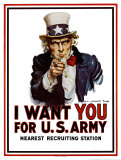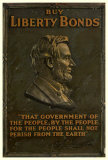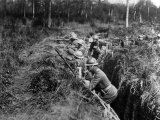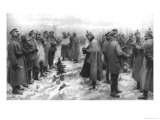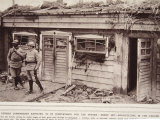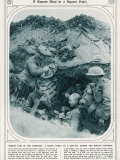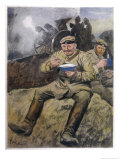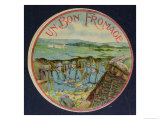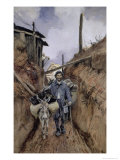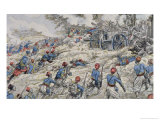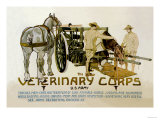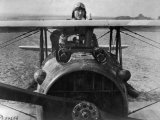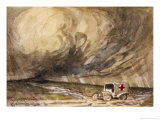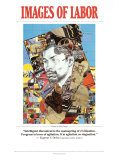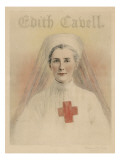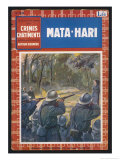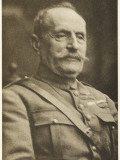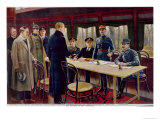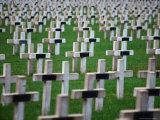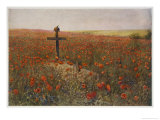|
|
|
|
|
|
|
|
|
|
|
|
|
READING ABOUT
WORLD WAR ONE
|
|
|
|
|
|
|
|
|
|
|
|
|
|
|
|
|
|
|
|
|
|
|
|
 |
|
|
|
History Posters & Prints: WW I, World War I, First World War
for classrooms, homeschoolers and history scholars.
|
history > WORLD WAR I | WWI pg 2 < social studies
|
|
The First World War, also known as the “Great War” and the “War to End All Wars”, was fought from 1914 - 1918 between the Allied Powers (Great Britain, France, Russia, the Serbian Kingdom [Balkan Peninsula], Italy and the United States), called the Triple Entente, and the Central Powers (Germany, Austria-Hungary and the Ottoman Empire), called the Triple Alliance.
Military tactics had failed to keep pace with advances in technology, such as airplanes and tanks. Aircraft in the form of balloons and Zeppelin were first used for reconnaissance, and then as bombers, but their stationary positions also made them targets. Serious aerial combat evolved when the pilots started shooting at one another with hand guns.
More that 9 million soldiers died, millions of civilians suffered, and 50-100 million more died in the worldwide influenza pandemic which followed in 1918-1919, possibly spread by the movement of massive numbers of soldiers.
|
|
|
|
|
|
|
America in the 20th Century -
World War I (1914-1919)
Poster Text: At first, the United States tried to stay out of World War One. Then, when it entered, the governemt described the war effort as another kind of progressive crusade – an effort “To make the world safe for democracy.” But in a way, the war brought on end to the Progressive Era, as millions of Americans lost interest in politics and crusades for refom. Horrified by the bloodshed, many of them longed for a quieter, more private age.
1). World War One began in Europe in the summer of 1914, when a Serbian nationalist assissinated the Archduke Ferdinand of Austria-Hungary. Armed to the teeth, and grouped in two great alliances, the most powerful nations of Europe all soon became involved in the conflict. Deadly modern weapons – the machine gun, the submarine, the tank, poison gas – and the misery of stalemate and trench warfare made this the worst war the world had yet experienced.
2). At first, President Woodrow Wilson promised that the United States would stay out of Europe's war. But most U.S. trade and billions in U.S. loans went to the Allies, especially Britain and France. And when German submarines sank the Lusitania, a British ship with 128 Americans on board, the country was outraged. Still, as the banner here suggest, most Americans continued to hope the U.S. could stay out of the conflict.
President Wilson was re-elected in 1916 on the slogan, “He kept us out of war.” But expanded German submarine attacks finally led the U.S. to join the conflict. On April 2, 1917, President Wilson went before Congress to ask it to declare war on Germany.
3). The governemt mounted a huge effort to convince Americans the war was worth fighting. This included recruiting posters, news bulletins, movies, rallies, speakers, and campaigns to sell Liberty Bonds. About 53,500 U.S. soldiers died from the influenza epidemic that ravaged the world while America was at war. But U.S. losses were nothing compared with the total of 10 million soldiers and 20 million civilians who died worldwide in this terrible conflict.
4). While most Americans supported the war, many did not. Some continued to believe the United States had nothing to gain from involvement in Europe's battles. Socialist leader Eugene V. Debs went to prison for urging workers to “resist militarism”.
5). President Wilson wanted World War One to be a “war to end all wars.” And at the Paris peace conference of 1919, he was able to get other nations to agree to establish the League of Nations to resolve international onflicts peacefully. But many Americans were tired of worrying about the troubles of the world. On a grueling trip across the country to win support for the League, on exhausted Woodrow Wilson suffered a stroke. His wife Edith had to help him finish out his term. And in the meantime, Congress failed to agree to let our own nation join the League. An era of isolationism had begun.
• America in the 20th Century posters
• William Jennings Bryan
|
|
|
|
|
|
|
RMS Lusitania: Sunk Without a Trace
On May 7, 1915 the British ocean liner Lusitania was torpedoed by a German submarine/U-Boat with the loss of 1,198 people. President Wilson vowed “America was too proud to fight”, and the US did not enter the war against the Germans until April 1917 when it was clear Germany was proposing to Mexico to ally with them against the US.
Among the notable people onboard the Lusitania were Elbert Hubbard, Rita Jolivet, and Alfred Gwynne Vanderbilt.
|
|
|
|
Buy Liberty Bonds
“That government of the people, by the people, for the people shall not perish from the Earth.” Abraham Lincoln
Liberty Bonds were a type of savings bonds as a way to support the war effort. In the Second World War they were called Defense Bonds.
• more Lincoln posters
|
|
|
|
General John “Black Jack” Pershing
b. 9-13-1860; Laclede, MO
d. 7-15-1948; Washington, DC
Pershing lead the American Expeditionary Force (AEF) and is considered the mentor of the US generals in the European Theatre of WWII.
Pershing's Crusaders was a 1918 film under “The auspices of the United States Government - The First Official American War Picture - Taken by the U.S. Signal Corps and Navy Photographers”.
Pershing served as a teacher in rural Missouri before he attended West Point. His experience with African American children helped with racial issues when he commanded a racially diverse unit of soldiers.
FYI - Pershing and WWII leader Omar Bradley were born within miles of one another.
• My Experiences in the World War by John Joseph Pershing
|
|
|
|
During World War I, the United States Armed Forces remained segregated by race. In 1913, New York established the 15th New York Infantry Regiment, a unit of the National Guard, which was mustered into Federal service in 1917. The 369th Infantry Regiment, popularly known as the Harlem Hellfighters, was known for being the first African-American Regiment during WWI.
Doughboy was the slang term used for the American Expeditionary Force (AEF) in World War I.
The term doughboy has been documented in use during the Mexican-American War (1846-48) to describe the “dusty” infantrymen, though the origin is unprovable.
• Black Military History posters
• flag posters
• 369th Infantry Regiment at Amazon
|
|
|
|
The Christmas Day Truce of 1914
On Christmas Eve, December 24, 1914, German troops began decorating the area around their trenches in the region of Ypres, Belgium, for Christmas by placing candles on trees, then singing Christmas carols, most notably Stille Nacht (Silent Night). The British troops then responded by singing English carols. Eventually the two side exchanged gifts and used the respite to retrieve fallen soldiers and perform burials. The movie Joyeux Noël is about the 1914 Truce.
This photograph was propaganda illustrating the “comfortable” living conditions available to German officers at the expense of their men in the trenches, by utilizing scrounged architecture components. |
|
|
|
Dinner Time in the Trenches: A Happy Party at a Dug-Out During the British Advance. -
It has often been said that the British troops are the best-fed in the world. And well they deserve it! Conditions in our trenches are different from what they were at the beginning when the Germans had an overwhelming preponderance of guns and men.
A British officer said to Mr. Philip Gibbs the other day: “Men who went through the misery of the old trench life for nine months of bad weather, never dry, never in physical comfort, always shelled, eating or sleeping or digging, feel that the time has come to get their own back. It is their turn, and they go out against the enemy with this thought in their brains, and it is this that gives then their dash and makes them reckless of any fire.” So Prussian Guards, Bradenburgers and Bavarian know. - (Official Photo.)
As a counterpoint to the English side of the story, here is how the Germans portrayed the conditions of the troops for their families.
• food posters
• Sharing Food lesson plan ideas |
|
|
|
The Somme and the Marne Rivers of France were the sites of WWI battles. The artist François Flameng is most remembered for his military paintings depicting World War I scenes. The Battle of the Somme from July to November of 1916 is one of the bloodiest military operations ever recorded with more than 1,000,000 casualties.
“Before the blackness of their burst had thinned or fallen the hand of time rested on the half-hour mark, and all along that old front line of the English there came a whistling and a crying. The men of the first wave climbed up the parapets, in tumult, darkness, and the presence of death, and having done with all pleasant things, advanced across No Man's Land to begin the Battle of the Somme.”
—The Old Front Line, John Masefield
|
|
|
|
In World War I, the trenches, machine guns, and barbed wire eliminated the cavalry charge from being an effective military tactic though horses and mules remained the reliable way to move materials to the Front.
It has been estimated that “over eight million horses died fighting in the war, 2.5 million horses were treated for injuries.”
|
|
The German Shepherd dog, breed to fix their traits of bravery, intelligence, and loyalty were brought back home by allied servicemen after the war.
|
|
|
|
WWI Aircraft
Aircraft in the form of balloons and Zeppelin were used early in World War I for reconnaissance, and then as bombers, but their stationary positions made them targets and ineffectual. Then the new innovations of novelty sports type planes developed in the ten years since the Wright Brothers first powered flight were pressed into service.
Serious aerial combat evolved when the pilots started shooting at one another with hand guns.
• more aviation posters
|
|
|
|
Marie Curie
Madame Curie helped set up x-ray machines in vans that could be taken out to help doctors treat the wounded.
An 18 year old named Ernest Hemingway served as a Red Cross ambulance driver in World War I when he couldn't enlist in the Army because of poor eyesight. Pierre Teilhard de Chardin was also an ambulance driver. |
|
|
|
Lillian Russell
née Helen Louise Leonard
b. 12-4-1860; Clinton, IA
d. 6-2-1922; Pennsylvania
Lillian Russell, as one of the best known and popular entertainers of the late 19th and early 20th centuries, did Marine recruitment and fundraising for the United States World War I effort.
|
|
|
|
Eugene V. Debs
b. 11-5-1855; Terre Haute, IN
d. 10-20-1926; PA
“Intelligent discontent is the mainspring of civilization. Progress is born of agitation. It is agitation or stagnation.” - Eugene V. Debs
Debs was one of the founders of the International Labor Union, the Industrial Workers of the World (IWW), and a five-time Socialist Party of America candidate for U. S. President. He was arrested under the Espionage Act of 1917 for protesting World War I and was sentenced to prison. President Warren B. Harding commuted his sentence to time served in 1921.
• more Images of Labor posters
• Walls and Bars by Eugene V. Debs
|
|
|
|
Edith Cavell
b. 12-4-1865; Norfolk, England
d. 10-12-1915; Belgium
Edith Cavell was a nurse and the matron of a Brussels, Belgium hospital taken over by the Red Cross at the outbreak of WWI. She was executed by a German firing squad for aiding allied soldier's escapes from occupied Belgium to neutral Netherlands.
|
|
|
|
|
|
|
Marshal Ferdinand Foch
b. 10-2-1851; Tarbes, France
d. 3-20-1929; Paris
Soldier, military theorist, and writer Ferdinand Foch served as general in the French army during World War I and was made Marshal of France in its final year of 1918.
Foch advocated peace terms that would make Germany unable to pose a threat to France ever again. He said of the Treaty of Versailles, “This is not a peace. It is an armistice for twenty years”; World War II started almost twenty years later.
|
|
|
|
An armistice treaty went into effect at 11 am (Paris time) on the 11th day of the 11th month, 1918, ending the World War I fighting on the Western Front. The Treaty of Versailles, ending the war between the Allied Powers and Germany was signed June 28, 1919 (five years after the assassination of Archduke Franz Ferdinand).
The Paris Peace Conference of 1919, where the Treaty was negotiate, was an attempt to “form a lasting peace throughout the world”, with the beginnings of the League of Nations. The “Big Four” refer to (from left to right), Lloyd George (UK), Vittorio Emanuele Orlando (Italy), Georges Clemenceau (FR), and Woodrow Wilson (US).
|
|
|
|
War Cemetery, Verdun, France
|
|
|
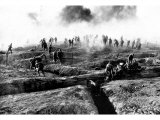
I Have a
Rendevous with Death |
|
Alan Seeger, an American, joined the French Foreign Legion in 1915, and died at the Battle of the Somme.
The poem, I Have A Rendezvous with Death, was published posthumously.
|
|
I HAVE a rendezvous with Death
At some disputed barricade,
When Spring comes back with rustling shade
And apple-blossoms fill the air—
I have a rendezvous with Death
When Spring brings back blue days and fair.
It may be he shall take my hand
And lead me into his dark land
And close my eyes and quench my breath—
It may be I shall pass him still.
I have a rendezvous with Death
On some scarred slope of battered hill,
When Spring comes round again this year
And the first meadow-flowers appear.
God knows 'twere better to be deep
Pillowed in silk and scented down,
Where love throbs out in blissful sleep,
Pulse nigh to pulse, and breath to breath,
Where hushed awakenings are dear...
But I've a rendezvous with Death
At midnight in some flaming town,
When Spring trips north again this year,
And I to my pledged word am true,
I shall not fail that rendezvous.
|
|
|
|
In Flander's Field
by Lieutenant Colonel John McCrae, MD (1872-1918)
Canadian Army
IN FLANDERS FIELDS the poppies blow
Between the crosses row on row,
That mark our place; and in the sky
The larks, still bravely singing, fly
Scarce heard amid the guns below.
We are the Dead. Short days ago
We lived, felt dawn, saw sunset glow,
Loved and were loved, and now we lie
In Flanders fields.
Take up our quarrel with the foe:
To you from failing hands we throw
The torch; be yours to hold it high.
If ye break faith with us who die
We shall not sleep, though poppies grow
In Flanders fields.
FYI ~ As the Poet Laureate of England from 1913-1930 Robert Bridges was an “enthusiastic ... needing no encouragement to shout for war (WWI)”. After the Treaty of Versailles he became a “vocal advocate of the League of Nations.”
|
|
previous page | top
|
|
I have searched the web for visual, text, and manipulative curriculum support materials - teaching posters, art prints, maps, charts, calendars, books and educational toys featuring famous people, places and events - to help teachers optimize their valuable time and budget.
Browsing the subject areas at NetPosterWorks.com is a learning experience where educators can plan context rich environments while comparing prices, special discounts, framing options and shipping from educational resources.
Thank you for starting your search for inspirational, motivational, and educational posters and learning materials at NetPosterWorks.com. If you need help please contact us.
|
|
|










